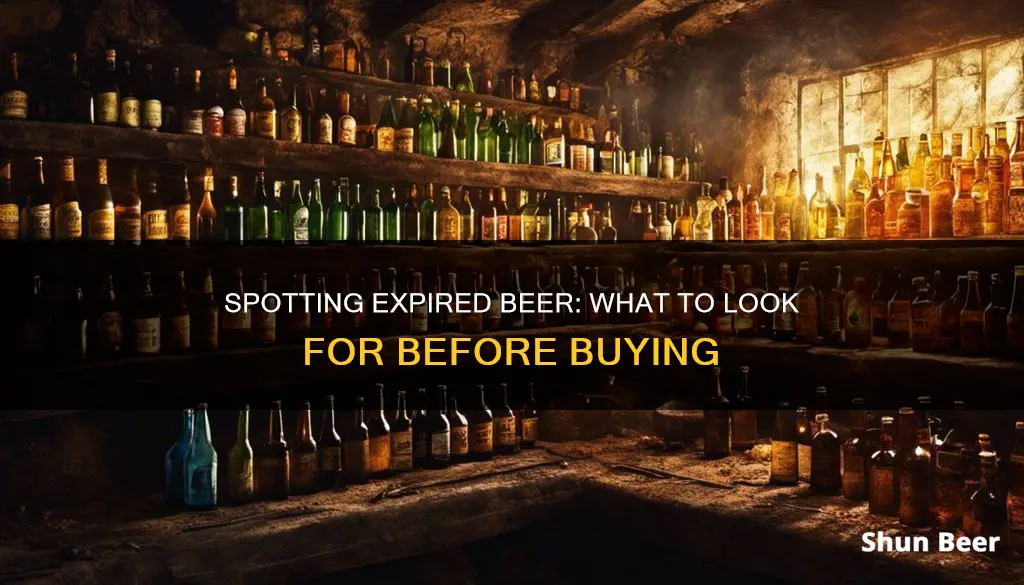
Beer lovers, rejoice! You probably won't get sick from drinking expired beer. But, before you buy, there are a few things to keep in mind to ensure you get the best brew possible. While beer doesn't spoil like perishable foods, it can lose its robust flavours over time. So, how can you tell if a beer is past its prime before you buy it?
Firstly, check the packaging for a best before date. This is a guideline on quality rather than safety, and beer will start to lose its freshness after this date. While not all beers have an expiration date, most will have a best before or born on date to help you gauge its freshness.
Secondly, examine the packaging for any signs of damage or improper sealing. Look out for excessive sediment at the bottom of the bottle, which could indicate poor taste.
Lastly, consider the type of beer. Lagers and ales typically have a shelf life of 6 to 12 months past the printed expiration date when stored correctly, while high-ABV beers like barley wines and imperial stouts can last for years and improve with age. On the other hand, IPAs and hoppy beers are best consumed within 3 to 6 months to enjoy their full hop character, as these flavours diminish over time.
By following these simple tips, you can ensure that you're getting a fresh and flavourful beer that's worth toasting to!
What You'll Learn
- Check the packaging for signs of damage or improper sealing
- Examine the colour, smell and taste for any off-flavours or aromas
- Look for a 'best before' date to gauge freshness
- Store beer in a cool, dark place, away from temperature fluctuations
- Avoid clear or green bottles, opt for brown bottles or aluminium cans

Check the packaging for signs of damage or improper sealing
When it comes to buying beer, it's important to be vigilant about the packaging. Here are some detailed tips on what to look for when checking the packaging for signs of damage or improper sealing:
First, carefully inspect the exterior of the packaging for any visible damage. Look out for dents, tears, punctures, or leaks. Even a small puncture in a can or a tear in a cardboard box can be a sign of a damaged seal, which could lead to oxygen exposure and beer oxidation. Oxidation can negatively affect the taste and quality of the beer, giving it a stale or cardboard-like flavour.
Next, check the bottle caps or can tabs to ensure they are intact and properly sealed. Look for any signs of tampering, such as a broken seal or a cap that doesn't seem securely fastened. Improper sealing could indicate that the beer has been exposed to oxygen, leading to potential spoilage.
Additionally, pay attention to the condition of the packaging material itself. For bottles, check for cracks or chips, as these could be entry points for oxygen, compromising the quality of the beer. For cans, inspect the seams to ensure they are tightly sealed and show no signs of corrosion or damage.
It's also important to consider the storage conditions of the beer. If the packaging looks damaged or the beer has been stored in direct sunlight or extreme temperatures, it's best to avoid purchasing it. Heat can accelerate oxidation and spoilage, and sunlight can cause a chemical reaction between UV light and hop compounds, resulting in an unpleasant "skunky" odour and taste.
Lastly, always check the "best before" date on the packaging. While beer can often be consumed past this date, it's a good indicator of the beer's freshness and quality. The closer you are to the "best before" date, the more likely the beer's flavour and aroma may have started to deteriorate.
By following these guidelines and carefully inspecting the packaging for any signs of damage or improper sealing, you can significantly reduce the risk of purchasing expired or spoiled beer. Remember, it's always better to be cautious when it comes to your beverage choices!
Where to Buy Piels Beer: Availability and Options
You may want to see also

Examine the colour, smell and taste for any off-flavours or aromas
When it comes to beer, you certainly don't want to drink anything that's gone off. While it's unlikely to make you sick, drinking expired beer can lead to some pretty unpleasant tastes and aromas. So, how can you tell if a beer is past its prime just by looking at it, smelling it, or tasting it?
Colour
One of the most obvious signs that a beer has expired is a change in colour. This could be a darkening of the beer or an increase in cloudiness or haze. These changes are often due to prolonged exposure to light and heat, which can cause the beer to oxidize and lose its fresh flavour.
Smell
Expired beer can give off some pretty nasty odours, ranging from mustiness and vinegar to wet cardboard and even rotten eggs. These unpleasant smells are typically caused by oxidation or bacterial infection during the brewing process.
Taste
As with the smell, the taste of expired beer can be quite off-putting. Common off-flavours include cardboard, skunkiness, sourness, buttered popcorn, creamed corn, and green apple. These undesirable flavours are often the result of oxidation, bacterial infection, or improper brewing techniques.
In summary, when examining the colour, smell, and taste of a beer for any off-flavours or aromas, look for changes in appearance, unusual odours, and unexpected flavours. By trusting your senses, you can avoid the unpleasant experience of drinking expired beer.
Buying Beer at Camp Randall: What You Need to Know
You may want to see also

Look for a 'best before' date to gauge freshness
When shopping for beer, it's always a good idea to check for a best-before date to gauge its freshness. This is different from a use-by date, which is a hard-and-fast rule for perishable foods like meat and dairy, where bacterial build-up can cause illness. Best-before dates are more of a guideline on quality, indicating when the beer will start to lose its freshness. Beer doesn't spoil in the same way that food does, but its flavour and quality will degrade over time.
Beers are not required to display a packaging date, but some brewers will include a best-before or expiration date. This is not mandatory, but it can be a sign of a higher-quality product. Checking for a best-before date is a good way to ensure that you're buying fresh beer and that it will taste as the brewer intended.
Be aware that different types of beer have different shelf lives. Beers with higher alcohol content, such as barley wines and imperial stouts, are sometimes brewed with aging in mind and can last for years. On the other hand, IPAs are best enjoyed as fresh as possible, as they start to lose their distinctive hoppy aroma within three to four months.
Buying Beer on Thanksgiving in Ohio: What's the Deal?
You may want to see also

Store beer in a cool, dark place, away from temperature fluctuations
Beer is best stored in a cool, dark place, away from temperature fluctuations. This is because heat speeds up oxidation, which can cause a stale or cardboard-like flavour. Major changes in temperature can also introduce oxygen into the beer when it thaws, which will further degrade the flavour. In addition, UV light can cause a chemical reaction with hop compounds, creating a skunky taste and smell.
Therefore, the ideal storage temperature for beer is between 45 and 55°F (7 and 13°C). Beer should be kept in a cool, dark place like a cellar or a closet. Brown bottles offer better protection against UV light than clear or green bottles, but aluminium cans are even better as they completely block out light.
If you don't have space in your fridge, a cool basement or cellar is a good alternative. Beer should be stored upright to minimise the surface area exposed to air, and kept away from strong odours to prevent flavour contamination.
It's also important to avoid vibration, which can disturb the sediment and affect carbonation. Beer should be consumed within a few months of purchase for the best flavour, depending on the type of beer and storage conditions.
Texas Memorial Day Beer Buying: What's the Deal?
You may want to see also

Avoid clear or green bottles, opt for brown bottles or aluminium cans
When it comes to buying beer, it's important to be vigilant about the packaging. Clear or green bottles, for instance, should be avoided. Beer packaged in such bottles is susceptible to "skunking", a phenomenon where the beer develops an unpleasant skunky odour and taste due to a photochemical reaction between UV light and hop compounds. This is a common issue, as clear and green glass bottles offer little to no protection against UV light, allowing the chemical reaction to occur.
So, what should you opt for? The answer lies in brown bottles or aluminium cans. Brown bottles offer superior protection against UV light, effectively blocking almost all of it. This safeguard ensures that your beer remains fresh and flavourful, preventing the undesirable "skunked" taste. Aluminium cans take it a step further, providing complete shielding from light, making them an even better option for preserving the quality of your beer.
By choosing brown bottles or aluminium cans, you can be confident that your beer is less likely to be affected by light exposure, thus prolonging its shelf life and maintaining its intended taste and aroma. This simple choice in packaging can make a significant difference in your beer-drinking experience, ensuring that you savour every sip without the unpleasant surprise of skunkiness.
Buying Alcohol in Madagascar: Wine and Beer Availability
You may want to see also
Frequently asked questions
Check the packaging for a "best before" or expiration date. If the beer is past this date, it may have expired. Beer usually lasts 6-12 months past the printed expiration date when stored in a cool, dark place.
Drinking expired beer will likely be unpleasant but it is unlikely to be dangerous. You won't get sick from drinking old beer, but the taste and quality will deteriorate over time.
Check the packaging for any signs of damage or improper sealing. Look for a "best before" date to gauge freshness. If the beer is past this date, it may be expired.
A skunky or sulfuric smell is a clear sign that the beer is bad. Other off-flavors and aromas include stale or cardboard-like, sour or vinegary, metallic, musty or moldy, and faded aroma.
Check for excessive sediment or floaties in the beer, which can be a sign of spoilage. Also, look for discoloration or unusual colors, such as a murky brown in a light beer, which may suggest contamination.







